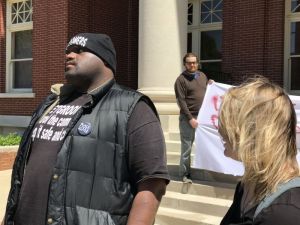Editor’s note: This interview was conducted because of WWII Heritage Days, taking place this weekend in Peachtree City. Please see the special section in this paper for more information about that event.
When Japanese airplanes struck Pearl Harbor by surprise Dec. 7, 1941, Bob Schmutzler of nearby Griffin was eating breakfast in the mess hall.
There was no time for Schmutzler to reach the anti-aircraft cannons he was trained to operate. Instead, he and more than 1,000 compatriots had to resort to the only weapons at hand: the 1903 Springfield rifle, which held five shots and had to be cocked prior to each fire.
In other words, they entered World War II using weapons leftover from World War I, Schmutzler said.
“The best way I can describe December 7 is chaotic,” said Schmutzler, who at 88 is one of the few men left standing from his generation. “… They were shooting holes in all our buildings. It was amazing they didn’t bother any of our guns. … They shot the barracks up and the mess halls. They could’ve stopped us right there.”
Despite having the single-fire rifles at their disposals, the Americans managed to knock down two Japanese planes nonetheless.
“Everybody says that’s impossible, but I always say if you get 1,500 people shooting at the same time, somebody’s bound to get lucky,” Schmutzler said, cracking a smile.
It is precisely this type of living history that will be showcased this Saturday and Sunday at the Dixie Wing Historical Airpower Facility at Peachtree City’s Falcon Field Airport. From 9 a.m. to 4 p.m. each day, the public will be treated to reenacted mock battles, demonstrations, guests speakers, vintage aircraft on display and much more.
For more information on the event, see the special section in today’s paper.
Schmutzler recalled that in addition to the noise from the attack, he was also stunned by the music accompanying it. In those days, there was no public address system to communicate with the camp at large, so all communication was conducted by buglers call, Schmutzler said.
“Meals were eaten by bugle call, everybody got paid by bugle calls, … so when we were attacked there was the call to arms, and we had never heard that call before,” Schmutzler recalled. “Somebody said ‘What’s the matter with that bugler, did he go out to town and get drunk or something?’”
Schmutzler caught himself in laughter.
“It’s funny now that you stop and look back at it … but it wasn’t funny at the time,” Schmutzler said.
Schmutzler may be retired, but the Griffin resident has dedicated himself to educating schoolchildren in the area about World War II.
Despite some cultural differences, “I have to explain what an Oldsmobile 88 is to them,” Schmutzler thoroughly enjoys interacting with high schoolers in particular.
“They are eager to learn, and they ask good questions,” Schmutzler said.
Schmutzler is a sought-after speaker on the topic, perhaps because he is keen on making sure to import more than the bare facts and figures.
“You’ve got to make it interesting,” Schmutzler said.
Among his more interesting anecdotes from the attack is the wry humor about a general who sent a low-priority message days before that U.S. operatives had lost track of a Japanese armada in the Pacific Ocean. The message was delayed all right: it was delivered to another general in the middle of the attack on Pearl Harbor, Schmutzler said.
“The message read ‘We lost contact with the Japanese fleet, be prepared for any eventuality,’” Schmutzler recalled.
Granted, time has made it easier to laugh, though the event itself was deadly serious for more than 2,000 American servicemen who died in the attack. Another 1,000 were wounded.
Yet, Schmutzler noted, the Japanese attack focused solely on the military but did not target any civilians. And despite the fact that two Japanese subs had snuck in the harbor before the steel gates could be closed, there was no attack on a hospital ship docked there, he added.
It was the U.S. gateway into World War II, which sent Schmutzler to the Fiji Islands, Guadalcanal and Bougainville.
Schmutzler and his five brothers all fought in the war, and when it was over they all came home safely. So many other families weren’t as lucky, he noted. More than 400,000 members of the U.S. military lost their life in WWII.
In addition to the love of his life, Luisa, whom he met while stationed at Fort Ord, California, Schmutzler still carries a torch for flying. And while he may not be in the pilot’s seat much anymore, he is looking forward to one final flight in one of the historically-maintained aircraft from the WWII era that is maintained by the Dixie Wing of the Commemorative Air Force.
And with a son also in the service, Schmutzler stays up to speed on the current state of the military, as wars are fought today in Afghanistan and Iraq under far different circumstances.
Back in his day, the enemy was easy to spot, being dressed in uniform, Schmutzler said. Today, however, the enemy comes in many forms, he noted.
And it’s one of the many reasons that whenever he meets a veteran, Schmutzler always takes time to stop and say thanks.









Leave a Comment
You must be logged in to post a comment.